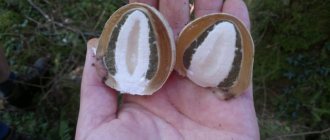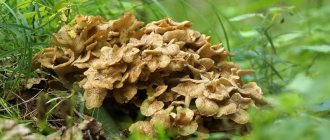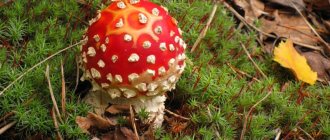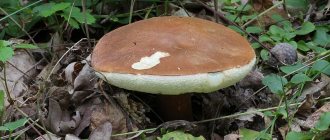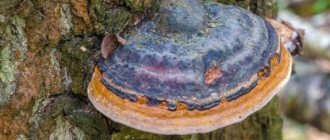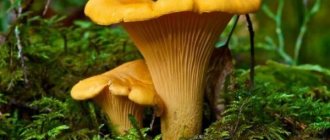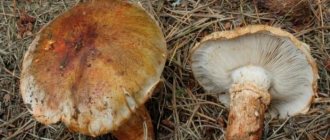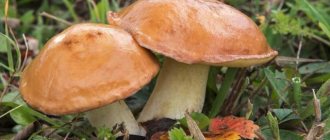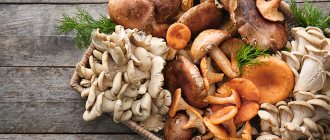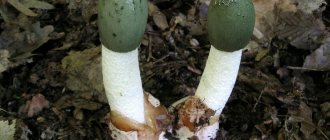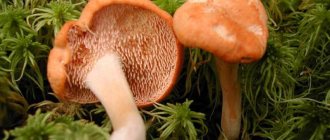Gray boletus (hornbeam) is a mushroom, a representative of the genus Leccinum, belonging to the Boletaceae family, sponge group.
Like all boletuses, hornbeam is an edible mushroom, but unlike the most famous boletus, it is not so widely distributed. Opinions vary regarding taste: some consider hornbeam a very tasty mushroom, others note the insufficient density of its cap as a drawback.
As for the benefits of hornbeam, its calorie content is equivalent to bread, and is more useful than cabbage and cucumbers. In cooking, hornbeam is used very widely for preparing a wide variety of dishes. Suitable for all types of workpieces.
In folk medicine, the hornbeam is not used as widely as its brother, the common boletus.
Grabovik. Latin name : Leccinum carpini.
Grabovik. Other names : gray boletus (elm), gray boletus.
Related species
Boletus is a group of species of mushrooms of the genus Leccinum (boletus). In addition to boletus, this genus includes a group of boletus. Representatives of both groups are edible mushrooms.
In addition to the species of hornbeam (gray boletus), several dozen species are classified as boletus. The most common:
- common boletus – Leccinum scabrum;
- Stiff boletus – Leccinum duriusculum;
- marsh boletus – Leccinum holopus;
- black boletus (black cap) – Leccinum melaneum;
- pink boletus – Leccinum oxydabile;
- checkerboard boletus (blackening) – Leccinum nigrescens;
- ash-gray boletus – Leccinum leucophaeum;
- colorful boletus – Leccinum variicolor.
Spiky raincoat
Remember those funny white mushrooms that “smoke” (this is, of course, spores) if you accidentally hit them with your foot? This is the spiny puffball - an edible mushroom of the champignon family. It is also called “pearl raincoat” - young mushrooms are beautiful, their surface is covered with small thorns that disappear over time, the flesh has a pearly tint. It is the snow-white young mushrooms that are eaten; when the flesh turns yellow, the puffball becomes inedible. This mushroom generally becomes unusable very quickly - its insides turn into a powdery spore mass, which bursts out through the hole formed in the top. It looks impressive, hence the nicknames “grandfather’s tobacco” and “dust duster”. The puffball does not have a cap with plates or a stem, so it is not difficult to distinguish it from other poisonous or edible mushrooms. They say that the spiny puffball is a very tasty mushroom that can be boiled, fried, pickled, frozen for future use, and even dried in a special dryer.
Photo: DPA/TASS/Usher, D.
False doubles
The boletus mushrooms are quite similar to each other, and since they are all edible, there will be no harm if, when collecting in a basket, for example, gray or harsh boletus mushrooms fall in with the common boletus mushrooms. It is much more important not to confuse them with poisonous mushrooms, which pose a threat not only to human health, but sometimes to human life.
The gray boletus (hornbeam) does not have a poisonous counterpart, however, there is a similar species, one of the names of which is false boletus or gall mushroom (Tylopilus felleus). Other names: mustard, false porcini mushroom. How to distinguish a hornbeam?
The gall mushroom is not poisonous, but it is also not suitable for food, since the taste of its pulp is very unpleasant, bitter, acrid, and does not disappear when cooked, but only intensifies. There is no smell. Even a small piece of false boletus can ruin the entire mushroom dish or preparation.
The cap of the gall mushroom is hemispherical, the skin is dry, velvety, with a small fluff. Color: brownish, light chestnut, chestnut, yellow. Diameter: 5-15 cm. The color of the tubes under the cap is pink. The spore powder is pink, mixed with dirty yellow spots. The texture of the pulp is “greasy”. White color.
The stalk of the gall fungus is slightly swollen at the bottom. Length: 4-13 cm, diameter: 1-3 cm. Color: cream, ocher, gray, brown. At the base it is covered with a special mesh pattern, reminiscent of a porcini mushroom, only dark in color.
The gall fungus prefers wetlands. It can be found in coniferous, deciduous and mixed forests, around stumps, near ditches, and in ravines. Can grow on rotten wood.
Distributed in Europe and Asia. Fruits from mid-summer until frost.
Distinctive features of gall fungus are:
- The hat is more voluminous and convex.
- In all boletus mushrooms, the texture of the cap is more dense, but in the gall mushroom, it is pressed in when lightly pressed and does not recover.
- The color of the hornbeam pulp is initially white, but when cut within 10 minutes. changes to pink or red.
- The color of the mesh on the leg is darker.
- There are no insects on the surface as they are not attracted to its bitter taste.
Yellow Ramaria, or Horntail
This mushroom has a coral-shaped shape, for which it received the nickname “deer horns” or “horned mushroom”. The fruiting body of yellow ramaria consists of several branching processes coming from one base. The length of the fruiting body can reach 10-15 centimeters, height – 6-20 centimeters, weight – up to three kilograms. The color of a young mushroom is usually uniformly yellow, although it may acquire other shades with age. The mushroom has a sweet smell and delicate taste; the Chinese call it “mushroom noodles” and artificially cultivate it. Rogatika is fried, boiled, stewed, but the yellow ramaria soup is especially tasty.
Wikipedia
Botanical description
The shape of the hornbeam cap changes as the mushroom grows: at a young age it is hemispherical, the edges are bent, then it opens up to cushion-shaped and flattened. The skin of a young mushroom is bare, velvety, uneven, wrinkled, and lumpy. In an adult it is dry, matte. In dry weather it often cracks; in older specimens it can shrink, exposing the pulp and tubes along the edge of the cap. In humid weather it becomes sticky.
The color of the cap is very varied: gray, gray-brown, yellow, yellow-brown, olive, olive-brown, brown, black-brown, black. Along the edges and in the middle - mustard yellow. Diameter: 3-15 cm.
The lower part of the cap (hymenophore) is a narrow, soft, slightly watery tube. The pores are small, round, angular-rounded.
The tubular layer is very loose, with small indentations near the stem. Thickness: 2.5-3 cm. The color of young mushrooms is whitish, creamy, and yellowish-gray in adults. When damaged it turns purple or gray.
The spores are fusiform. Size: 10-20×5-7 microns. Color: gray-brown, brown.
The stalk of the hornbeam is solid, longitudinally fibrous, in a young mushroom it is strongly swollen, then it becomes cylindrical with a club-shaped base. Color: white, cream, yellow-brown, brown, lighter at the top, darker towards the ground, darkens when pressed. Covered with scales, the color of which, as the mushroom matures, changes from whitish, light yellow to dark brown, brown, black. Height: 5-16 cm, diameter: 0.8-4 cm.
The flesh of the hornbeam cap is soft, the legs are fibrous, and in old mushrooms it is somewhat harsh. The cut color is initially whitish, pale yellow, but quickly changes to pinkish, pinkish-violet, and then gray and black, becoming hard. There is no pronounced smell or taste.
What can the gray boletus be confused with?
Hornbeam is very easy to confuse with boletus. There are several types of them, and the hornbeam is similar to absolutely all of them. There are common boletus, marsh boletus, checkerboard boletus, multi-colored boletus, pinkish boletus, ashen boletus, harsh boletus and black boletus.
All these mushrooms have a similar structure and are almost identical in the color of the cap. However, they have different taste properties.
Also, hornbeam can be confused with gall mushroom. It grows mainly in central Russia and is very similar to hornbeam during the period of its active growth. However, this mushroom is inedible, has a bitter taste and can often be harmful to health. Therefore, it is very dangerous to confuse these two types. Before you collect the hornbeam in your basket, make sure that it is not a gall fungus. This is quite easy to determine. The bile fungus does not darken when exposed to oxygen. And the hornbeam becomes gray and even black literally a few minutes after interacting with air. Do this experiment and see the result.
Habitat
Gray boletus (hornbeam) is found in North America and Eurasia. In Russia, it is distributed in the southern regions and the Caucasus.
Where does hornbeam grow? The fungus forms mycorrhiza (symbiosis with the roots of a plant), most often with hornbeam, hence the name of the plant, so it should be looked for near these trees. It is also found under hazel (hazel), poplar, birch, and beech.
The hornbeam prefers bright places. It can be found in deciduous forests and groves where the listed plants grow, in forest clearings, forest edges, and the sides of forest roads. Often grows alone, but can form families.
Natural remedies for constipation
There are a number of different ways to soften stool naturally, including dietary changes, physical activity and nutritional supplements. These include:
Cellulose
Most plant foods contain fiber (fiber). There are two types of fibers: soluble and insoluble.
Insoluble fibers are most useful for softening stool. They do not dissolve in water and help food pass from the stomach to the intestines faster.
Whole grain flour, nuts, beans and vegetables such as cauliflower, green beans and potatoes contain insoluble fiber.
It is necessary to gradually increase your fiber intake and drink more water, which helps smooth the passage of fiber through the digestive tract.
Research has shown that psyllium husk and wheat bran increase the water content of stool, which has a softening effect on the stool. Finely ground wheat bran had the opposite effect and reduced the water content of the stool.
Physical exercise
The active state has many health benefits, including improved intestinal motility. Movement helps stimulate the digestive system. Research has shown that exercise is an effective treatment for people with constipation.
Activity increases your body's need for water, so it's important to drink plenty before, during, and after exercise to keep your stool soft. For people who find it difficult to exercise, there are many easy workout options
These include yoga exercises specifically aimed at improving digestion. Pregnant women can also benefit from yoga tailored to their specific needs.
Probiotics
Probiotics are live, beneficial bacteria found naturally in fermented foods, including kefir, sauerkraut, yogurt, kimchi, miso, kombucha and tempeh. They are also available in supplements and yogurt-type drinks.
Probiotics help maintain the gut microbiome—the collection of trillions of microbes in the gut that keep the body healthy and balanced. Consuming probiotics increases the number of beneficial bacteria in the gut and improves digestion.
Studies have shown that taking probiotics helps soften stools and increase the frequency of bowel movements. Probiotics are safe for most people, including children, women who are pregnant or breastfeeding, and older adults. But before consuming them, you should consult a doctor or nutritionist.
Olive oil
The fats in olive oil help relieve constipation in two ways:
- smoothing the inside of the intestines, making it easier to pass stool,
- helping to retain more water, making stools softer.
One tablespoon of olive oil taken on an empty stomach can relieve constipation in most adults. Doctors do not recommend giving olive oil to children.
A study of 50 people with constipation found that olive oil, flaxseed oil and mineral oil were equally effective in relieving constipation symptoms in people undergoing dialysis.
Aloe vera
Aloe vera juice is obtained from the leaves of the plant. Aloe leaves are rich in compounds that help relieve inflammation of the digestive tract. To soften stool, a person can consume aloe vera juice by adding it to smoothies and juices or drinking it on its own.
Doctors do not recommend drinking aloe vera juice during pregnancy or while breastfeeding. Doctors also do not recommend it for children under 12 months of age. Some people may be allergic to aloe vera. Before drinking the juice, apply a small amount of aloe vera to the inside of your forearm. If no reaction occurs within 24 hours, then it is safe to try the juice.
Epsom salt
Epsom salt looks like table salt but contains minerals such as magnesium and sulfate. Epsom salts are often added to bath water to soothe aching muscles, but can also be taken orally as a natural treatment for constipation. Salt increases the amount of water in the intestines and softens the stool.
A study of 106 people with functional constipation found that drinking magnesium sulfate-rich mineral water daily improved stool frequency and consistency.
Doctors don't recommend Epsom salts for children under 6 and don't know if it's safe for pregnant or breastfeeding women, so they might want to avoid trying it.
Chemical composition
Hornbeam is a valuable food product that, with a low calorie content, contains a rich set of vitamins, macro- and microelements. The beneficial properties of hornbeam are determined by the components in its composition. Protein, leucine, terosine, glutamine, etc. are found in the mushroom.
In addition, hornbeam contains vitamins A, B1 (0.07 mg.), B2 (0.22 mg.), E (0.1 mg.), PP (6.7 mg.), ascorbic acid (6 mg.) , as well as potassium (443 mg.), phosphorus (171 mg.), magnesium (15 mg.), calcium (6 mg.), sodium (3 mg.), manganese (0.74 mg.), iron (0 ,3 mg.).
Edible
Is it possible to eat hornbeam?
The answer to this question can be unequivocally yes. For all the time this mushroom has been known, no cases of poisoning have been recorded. This means that the mushroom is absolutely safe. This is mentioned in numerous works of scientists who studied the properties of hornbeam.
Hornbeam mushrooms have exactly the same taste properties as boletus mushrooms. At the same time, its spongy layer is not so pleasant to the taste, this slightly reduces the value of this mushroom. Hornbeam has a slightly sweetish taste and is a little difficult to chew, but if it is well thermally processed, it becomes an excellent addition to a vegetable side dish.
Calories and nutritional value
Hornbeam mushroom is a low-calorie product and has the following nutritional value (per 100 grams of product):
| Name | Quantity, gr. |
| Calories, kcal | 20 |
| Squirrels | 2,1 |
| Fats | 0,8 |
| Carbohydrates | 1,2 |
| Alimentary fiber | 5,1 |
Veselka vulgaris
Our list ends with a mushroom that is known primarily for its shape, but not all mushroom pickers know that the common mushroom is edible. The mature mushroom strongly resembles the male genital organs, for which traditional medicine has endowed it with specific healing qualities. The young fruiting body is white and ovoid with a diameter of up to six centimeters. Then a hollow, leg-like, cylindrical receptacle grows from it, 12 to 22 centimeters long and up to four centimeters in diameter. The leg is crowned with a cap with a cellular surface covered with a mucous layer. During the growth period, the leg can increase by 5 mm per minute. The mushroom is considered very tasty and delicious and is mainly collected at the egg stage or when it has just sprouted. Veselka is eaten raw or cooked; making all kinds of medicinal tinctures is very popular. However, remember: if you have little idea how to distinguish a Veselka egg from a champignon, a young fly agaric or a young pale toadstool, do not take it.
Imago/TASS
How to collect
The hornbeam harvesting season begins in June and lasts until the end of October. The first mushrooms can be collected when the mountain ash begins to bloom. The second wave appears after haymaking, at harvest. The third - after the departure of the swifts.
The best time to collect is early in the morning, when there is dew, when there is still a night chill in the air, as well as in the rain or immediately after the rain. Mushrooms collected at this time retain their fresh appearance longer.
Also, a few days after the rain, especially in warm weather, you can expect a new batch of gray boletus to appear.
Where is hornbeam collected? As already mentioned, hornbeam forms mycorrhiza with hornbeam, hazel (hazel), poplar, birch, and beech. It settles at the foot of these plants. Another plus is that the gray boletus prefers open, bright places and does not hide in the grass.
The optimal ones for collecting are young mushrooms, old and overgrown specimens, although they are edible, their nutritional value is lower. Hornbeams are more often damaged by worms than other mushrooms, so damaged specimens should be discarded even at the collection stage.
How to trim a hornbeam? Traditionally, a sharp knife is used for this. In addition, mushrooms of this type can be twisted out of the soil, for which they are first shaken from side to side. After removing the mushroom, the growth site should be sprinkled with soil and leaves, which makes it possible to form a new crop in this place.
You should also note that mushrooms tend to accumulate all kinds of toxins and heavy metals from the soil. Therefore, for collection you should choose environmentally friendly places, away from industrial enterprises, roads, etc.
Growing
The growing process is similar to the cultivation of porcini mushrooms. But the productivity of gray boletus is distinguished by better indicators. The optimal time for sowing is from May to the end of August.
Process steps:
- Prepare the area and remove debris.
- Around the birch tree, holes are dug for “seeds” 20 cm deep and 10 cm in diameter. The tree must be at least 4 years old, otherwise the beginning of fruiting will be delayed.
- The holes are filled with a mixture of soil and peat.
- Place a piece of compost mycelium and cover it with soil.
- Compacted.
To increase fruiting, you should properly care for the mycelium. In the dry season, it is necessary to ensure soil moisture by sprinkling. To do this, use a spray bottle. Water the garden bed in the afternoon to avoid direct sunlight. Low herbaceous plants are often planted nearby. They do not interfere with the penetration of light, but can provide protection from the sun.
Fertilizing can increase productivity. The products are purchased in a specialized store. Use according to instructions. When cold weather sets in, the area is covered with straw, spruce branches, fallen leaves, and moss. When it gets warm, the protection is removed.
Mushrooms appear in the first year of cultivation. From 5 to 15 fruiting bodies grow around the tree. The highest fruiting occurs in the 2nd year after planting. After 5 years, the amount of harvest decreases.
How to store hornbeam
An important point when preparing a rakes is the container. Plastic bags are not suitable for these purposes, since mushrooms will rot in them and quickly deteriorate. The best option is a traditional basket: it allows air to pass through and allows the mushrooms to lie freely without squeezing each other.
Also, when looking for mushrooms under the leaves, a long stick with a spear at the end is a good helper. It also protects against contact with poisonous plants.
Hornbeam is a plant that, due to the loose texture of the cap, cannot be stored for a long time and should be processed as quickly as possible. Experts recommend doing this within 12 hours after collection.
After returning home, the mushrooms are carefully sorted. First of all, the collected hornbeams are checked for the presence of worms, for which they are cut and carefully examined. If infected parts are found, they are cut out. Completely affected specimens are discarded.
Mushrooms whose individual parts are darker in color must also be removed, which may be a sign of rotting.
Gray boletus (hornbeam) has high taste properties and is suitable for all types of preparations. It can be frozen, dried, salted, pickled.
Preliminary preparation
For any type of workpiece, with the exception of drying, the first stage of using a rakes is pre-processing.
- Mushrooms are wiped with a sponge to remove dirt, moss, etc. Particular attention is paid to the base of the leg.
- If the hornbeam is collected on sandy soil, then the leg should be scraped using a knife.
- In old specimens, the tubular layer is removed. It can be left only if the mushrooms are intended for pickling or pickling.
- In a sufficiently large container, fill the boletus mushrooms with plenty of water and wash them thoroughly by hand. The procedure is repeated several times. Then the mushrooms are poured with water and left to soak, during which various debris and impurities that are easy to remove lag behind them.
- The washed mushrooms are placed in a colander and the water is allowed to drain.
The next mandatory stage of preliminary preparation is boiling. How to cook hornbeam? Boiling is carried out in two stages: at the beginning, to remove debris and pests, the mushrooms are filled with water, brought to a boil, and the liquid is drained. Then cook in clean salted water until tender - about 20 minutes.
Boiled mushrooms are stored in the refrigerator for no longer than two days. They can also be placed in plastic bags with sealed valves and frozen. In the latter case, the shelf life increases significantly.
How to cook
The taste of the hornbeam is reminiscent of the common boletus and culinary recipes for it can be safely borrowed from its relative. There are a lot of ways to prepare hornbeam and they are very diverse. The mushroom is tasty in almost any form and is used to prepare sauces, soups, stir-fries, as a filling for pies, fried, and stewed. Suitable as a component for other dishes.
You should also pay attention to the fact that in its raw form, hornbeam is harmful to health; only after heat treatment are the taste and aroma of the mushroom fully revealed.
Horn-shaped funnelwort
The rather scary-looking funnel-horned funnel is considered a delicacy in Western Europe. For its black horns, the mushroom received gloomy names: in Germany - the trumpet of the dead (Totentrompete), in France - the trumpet of death (Trompette de la mort), the British turned out to be more positive and called it the cornucopia (Horn of Plenty). So, the mushroom has tube-shaped or cup-shaped hollow fruiting bodies, tapering towards the base. The hat is a deep funnel with a wavy edge turned outward. The height of the fruiting bodies can reach 12 centimeters, the diameter of the cap is up to eight centimeters. The spore-bearing hymenium of the funnel funnel is located on the outer tuberous surface; when the spores mature, it looks gray. The inside color can vary from black-brown to dark gray. The flesh of the mushroom is also dark in color, thin and brittle. Raw mushrooms have practically no smell and taste, but they intensify with heat treatment and drying. “Trumpets of Death” are fried, steamed, dried, boiled, and used to make sauces and seasonings.
Wikipedia
Contraindications
Whatever the useful product and whatever gastronomic qualities it has, before consuming it is necessary to take into account the benefits and harm that hornbeam can cause. Hornbeam is a heavy food for the digestive system. In large quantities may cause stomach upset.
In addition, in rare cases, individual intolerance is possible. Therefore, when first getting acquainted with dishes with hornbeam, it is better to limit yourself to a small amount.
Also, gray boletus (hornbeam) is contraindicated for stomach and duodenal ulcers. It should not be used by children.
Literature:
A.P. Umeltsev. Encyclopedia of mushroom picker.
Aurel Dermek. Mushrooms.
Anna Romanova, Alla Bulatova. Mushrooms. Illustrated guide to collection, processing, storage.
Damage to the fly mushroom
Frequent consumption of mushrooms in large quantities is extremely undesirable for people with digestive disorders. Fly mushrooms, which are difficult to digest, may aggravate the disease.
It is important for people with allergies to mushrooms or chronic liver diseases to avoid the product. They should not be given to children under 3 years of age in any form.
And absolutely everyone is prohibited from eating mushrooms collected in contaminated areas, along highways or near industrial facilities. Such a product accumulates a huge amount of carcinogens in the pulp and turns from being quite useful into poison.
As already mentioned, fly mushrooms are not poisonous. But only if the basket contains a real fly agaric, and not the similar panther fly agaric - one of the most poisonous forest inhabitants. In order not to be mistaken, you need to remember that fly agarics are tubular mushrooms, and fly agaric mushrooms are lamellar.
Crested hedgehog
In appearance, the combed hedgehog (pictured above) is a pile of long hanging light “stalactites”. Some mushrooms look like a hedgehog, some are more like a waterfall of boiled noodles. The mushroom has a fruiting body measuring up to 20 centimeters and weighing up to 1.5 kilograms, the color varies from white to beige. As a rule, it grows on the trunks of deciduous trees, including dead ones. The pulp of the combed manger is aromatic, fleshy, reminiscent of shrimp or crab meat. Those who have tried the hedgehog say that it is a delicious delicacy with a subtle sweetish taste. The wild mushroom is highly valued in folk medicine, but is rare. In Russia, it is listed in the Red Books of the Primorsky Territory and the Jewish Autonomous Region. It is grown artificially in China.
Basic rules for a mushroom picker
Before you go into the forest to pick mushrooms, you need to familiarize yourself with a number of rules that will help you understand toxicity and edibility.
Forest gifts that pose a mortal danger to life must be recognized by their appearance.
Signs of harmful mushrooms:
- All of them are classified as lamellar. There are specimens of tubulars that are not used for food, among which there are no deadly species. You need to be very careful with such mushrooms;
- Poisonous mushrooms include the fly agaric family. They can be recognized by the tophi at the root of the stem, the ring-shaped collar under the cap;
- summer honey fungus has a thin fringe along the inner border of the cap and a ring inside it. To avoid eating a poisoned product, you do not need to collect honey mushrooms in the summer months under coniferous trees;
- Patouillard fiber is a mushroom with a very pungent, unpleasant odor, similar to industrial alcohol. Its flesh quickly turns red once you break it into pieces.
The forest is full of many other mushrooms that poison the body, but they do not lead to death.
Be able to distinguish mushrooms that are similar to each other
Often inedible specimens are so camouflaged that even an experienced forester is unable to distinguish them as valuable ones.
How to recognize mushrooms for toxicity?
The poisonous, bilious satanic mushroom differs from the edible white type of boletus in its pulp: when broken, it acquires a pink or red tint.
Compared to butterfly and moss mushroom, the pepper inedible mushroom has a very bitter taste.
Sulfur-yellow, brick-red poisonous honey fungus does not have rings on its stem. The color of the plates is not creamy, like that of its edible counterpart.
The difference between champignon and toadstool lies in the plates. Toadstool is white, while champignons are pink and brown.
The edible russula differs from the pale toadstool in that it lacks a ring and a volva with a tophi on the stalk.
Do not collect previously known, life-threatening mushrooms
Toxic products are considered:
- The thin pig is a delayed impact bomb. It contains an antigen protein that can accumulate over many years and then trigger the autoimmune effects of blood clotting. A person dies unexpectedly from heart disease or thrombosis. At the same time, few people will be able to realize that long-term intoxication with pig was the cause of his death;
- greenfinch includes substances that are not excreted from the body. When accumulated, they lead to deterioration in kidney and muscle function, and thicken the blood;
- The stitching has hydromyrin. If you cook mushrooms, even following all the rules, and eat them 2–3 times, you can develop liver and kidney diseases.
Do not collect forest products in industrial areas
Forest products need to be collected at a distance of 200 - 300 meters from the road. In the case of a shorter distance, lead from exhaust gases, which accumulates in mushrooms, settles on the kidneys and bones, and then leads to disability. If the mushrooms are overgrown or have worms, they are already filled with decay products, the remains of the larvae.
Don't trust fiction
Many people believe in some existing signs. For example, if a mushroom is eaten by insect larvae, it is good. This is a lie, because substances that are not dangerous to insects can be destructive to humans.
Also, if the found specimen has a good taste, then it can be consumed. All varieties of fly agaric are tasty and at the same time toxic.
All young specimens can be eaten without fear for life. Often, the accumulation of toxins in the body occurs over time. Moreover, the toadstool is dangerous from the moment it appears.
If you know how to check the harvest, toxic and dangerous trophies will not be present in the basket.
